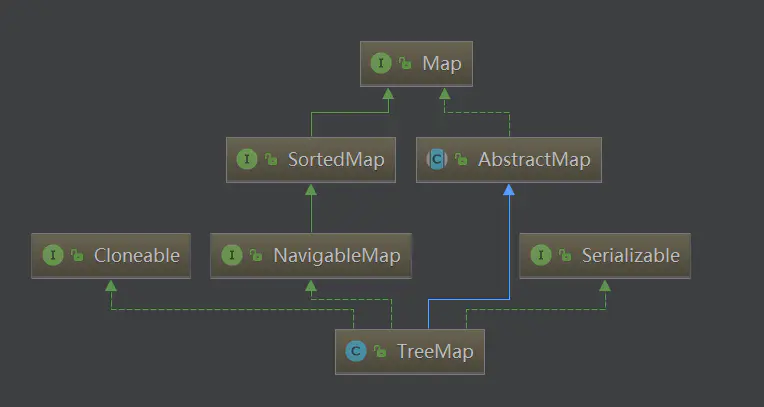TreeMap
TreeMap是红黑树的java实现。相比HashMap来说,TreeMap多实现了一个接口NavigableMap,也就是这个接口,决定了TreeMap与HashMap的不同:HashMap的key是无序的,TreeMap的key是有序的。

源码展示:

public class TreeMap<K,V> extends AbstractMap<K,V> implements NavigableMap<K,V>, Cloneable, java.io.Serializable { /** * The comparator used to maintain order in this tree map, or null if it uses the natural ordering of its keys. */ private final Comparator<? super K> comparator; private transient Entry<K,V> root; //根节点 /** * The number of entries in the tree */ private transient int size = 0; /** * The number of structural modifications to the tree. */ private transient int modCount = 0; /** * Constructs a new, empty tree map, using the natural ordering of its keys.*/ public TreeMap() { comparator = null; } /** * Constructs a new, empty tree map, ordered according to the given comparator. */ public TreeMap(Comparator<? super K> comparator) { this.comparator = comparator; } /** * Constructs a new tree map containing the same mappings as the given map, ordered according to the <em>natural ordering</em> of its keys.*/ public TreeMap(Map<? extends K, ? extends V> m) { comparator = null; putAll(m); } /** * Constructs a new tree map containing the same mappings and using the same ordering as the specified sorted map.This method runs in linear time.*/ public TreeMap(SortedMap<K, ? extends V> m) { comparator = m.comparator(); try { buildFromSorted(m.size(), m.entrySet().iterator(), null, null); } catch (java.io.IOException cannotHappen) { } catch (ClassNotFoundException cannotHappen) { } } }
红黑树相关操作可见 源码分析之Map(三)HashMap
LinkedHashMap
LinkedHashMap是HashMap的子类,所以也具备HashMap的诸多特性。不同的是,LinkedHashMap还维护了一个双向链表,以保证通过Iterator遍历时顺序与插入顺序一致。除此之外,它还支持Access Order,即按照元素被访问的顺序来排序源码展示:

public class LinkedHashMap<K,V> extends HashMap<K,V> implements Map<K,V>{ /** * HashMap.Node subclass for normal LinkedHashMap entries. 存储元素的结构 */ static class Entry<K,V> extends HashMap.Node<K,V> { Entry<K,V> before, after; Entry(int hash, K key, V value, Node<K,V> next) { super(hash, key, value, next); } } /** * The head (eldest) of the doubly linked list. 双向链表的头节点 */ transient LinkedHashMap.Entry<K,V> head; /** * The tail (youngest) of the doubly linked list. 双向链表的尾节点 */ transient LinkedHashMap.Entry<K,V> tail; /** * The iteration ordering method for this linked hash map: <tt>true</tt> * for access-order, <tt>false</tt> for insertion-order. true为访问顺序 false为插入顺序 * * @serial */ final boolean accessOrder; /** * Constructs an empty insertion-ordered <tt>LinkedHashMap</tt> instance with the specified initial capacity and load factor.*/ public LinkedHashMap(int initialCapacity, float loadFactor) { super(initialCapacity, loadFactor); accessOrder = false; } /** * Constructs an empty insertion-ordered <tt>LinkedHashMap</tt> instance with the specified initial capacity and a default load factor (0.75).*/ public LinkedHashMap(int initialCapacity) { super(initialCapacity); accessOrder = false; } /** * Constructs an empty insertion-ordered <tt>LinkedHashMap</tt> instance with the default initial capacity (16) and load factor (0.75). */ public LinkedHashMap() { super(); accessOrder = false; } /** * Constructs an insertion-ordered <tt>LinkedHashMap</tt> instance with the same mappings as the specified map. */ public LinkedHashMap(Map<? extends K, ? extends V> m) { super(); accessOrder = false; putMapEntries(m, false); } /** * Constructs an empty <tt>LinkedHashMap</tt> instance with the specified initial capacity, load factor and ordering mode.*/ public LinkedHashMap(int initialCapacity,float loadFactor,boolean accessOrder) { super(initialCapacity, loadFactor); this.accessOrder = accessOrder; } }
特性对比
| HashMap | LinkedHashMap | TreeMap | concurrentHashMap | |
| 原理 | HashMap内部是基于哈希表实现的键值对存储。当我们将键值对传递给put()方法时,它调用键对象的hashCode()方法来计算hashcode,让后找到bucket位置来储存值对象。hashcode相同时,会储存在同一个bucket位置的LinkedList中,在一定条件下,LinkedList会转为红黑树 | LinkedHashMap是继承自HashMap,底层使用哈希表与双向链表来保存所有元素。顺序可以分为插入顺序和访问顺序,是根据成员变量accessOrder决定的。其访问顺序可以实现LRU | TreeMap实现了SotredMap接口,它是有序的集合。而且是一个红黑树结构,每个key-value都作为一个红黑树的节点。如果在调用TreeMap的构造函数时没有指定比较器,则根据key执行自然排序。 | ConcurrentHashMap相比HashMap而言,是多线程安全的,其底层数据与HashMap的数据结构相同。而HashTable虽然是线程安全的,方法都是用Synchronized修饰的,但争夺的都是同一个对象锁,在高并发的情况下,会产生效率低,等待时间长的问题。concurrentHashMap 很多地方使用了cas操作和分段加锁,加锁的最小单位是Hash桶,这使得ConcurrentHashMap效率大大提升. |
| 线程安全 | 否 | 否 | 否 | 是 |
| 初始容量 | 16 | 16 | 0 | 16 |
| 存储结构 | 数组+链表/红黑树 | 数组+链表/红黑树,HashMap子类 | 红黑树 | 数组+链表/红黑树 |
| 顺序规则 | 无序 | 访问顺序或插入顺序 | key的自然顺序或自定义顺序 | 无序 |
| 存储特点 | 最多一条记录的key为null | 最多一条记录的key为null | key的自然顺序时不能为null | 不能存null |
| 插入效率 | 高 | 高 | 较高(需要比较排序) | 较高 |
| 时间复杂度 | O(1) | O(n) | O(log(n)) | O(1) |
